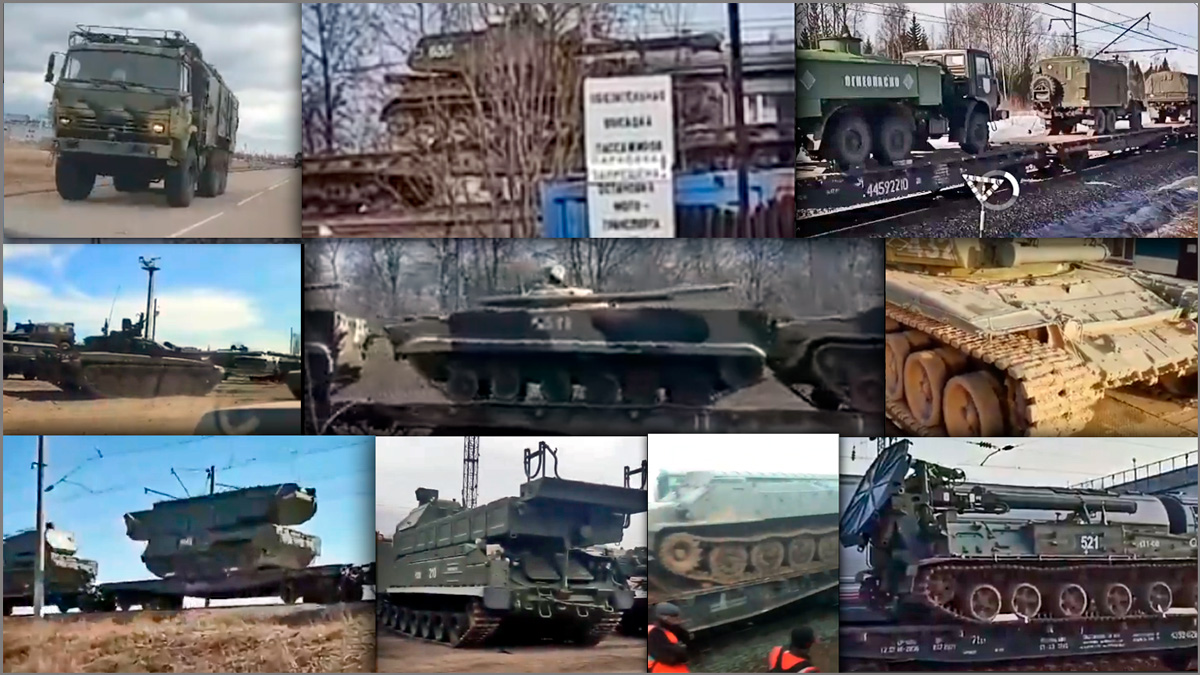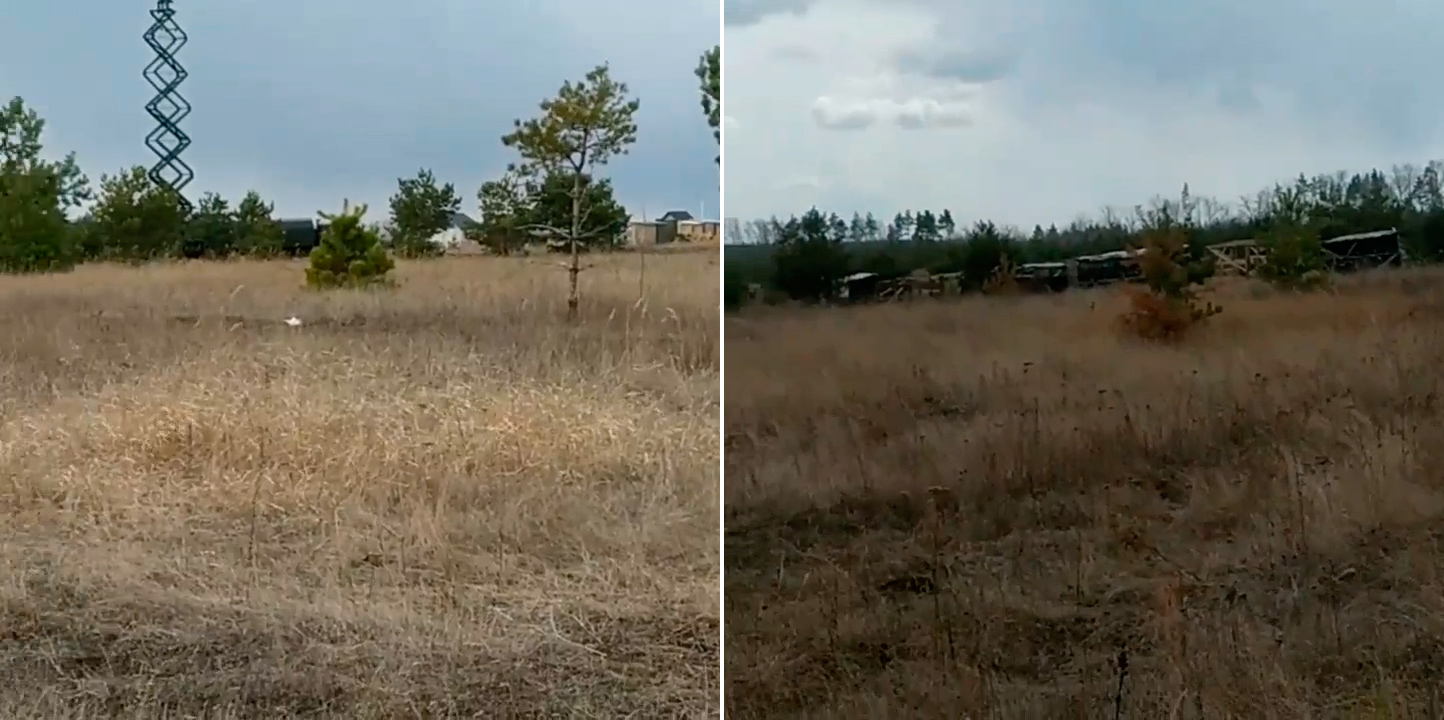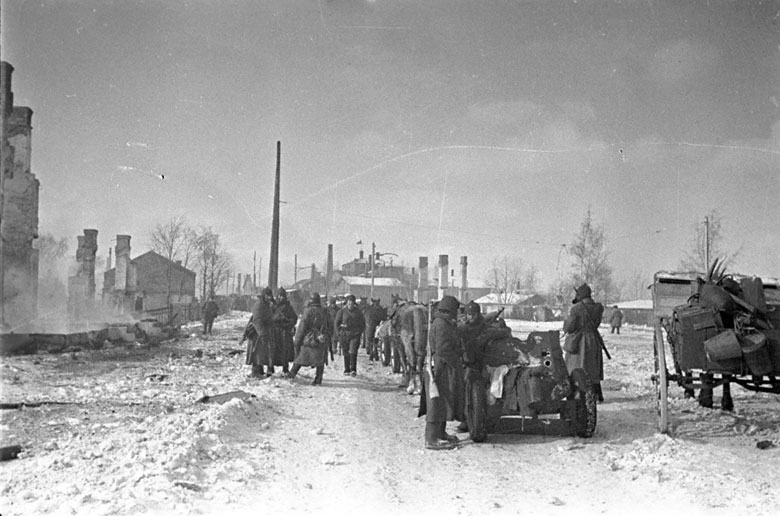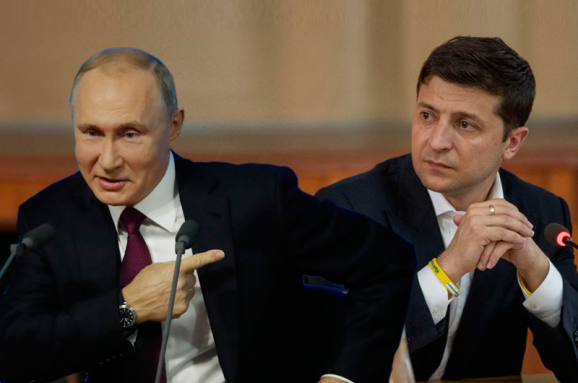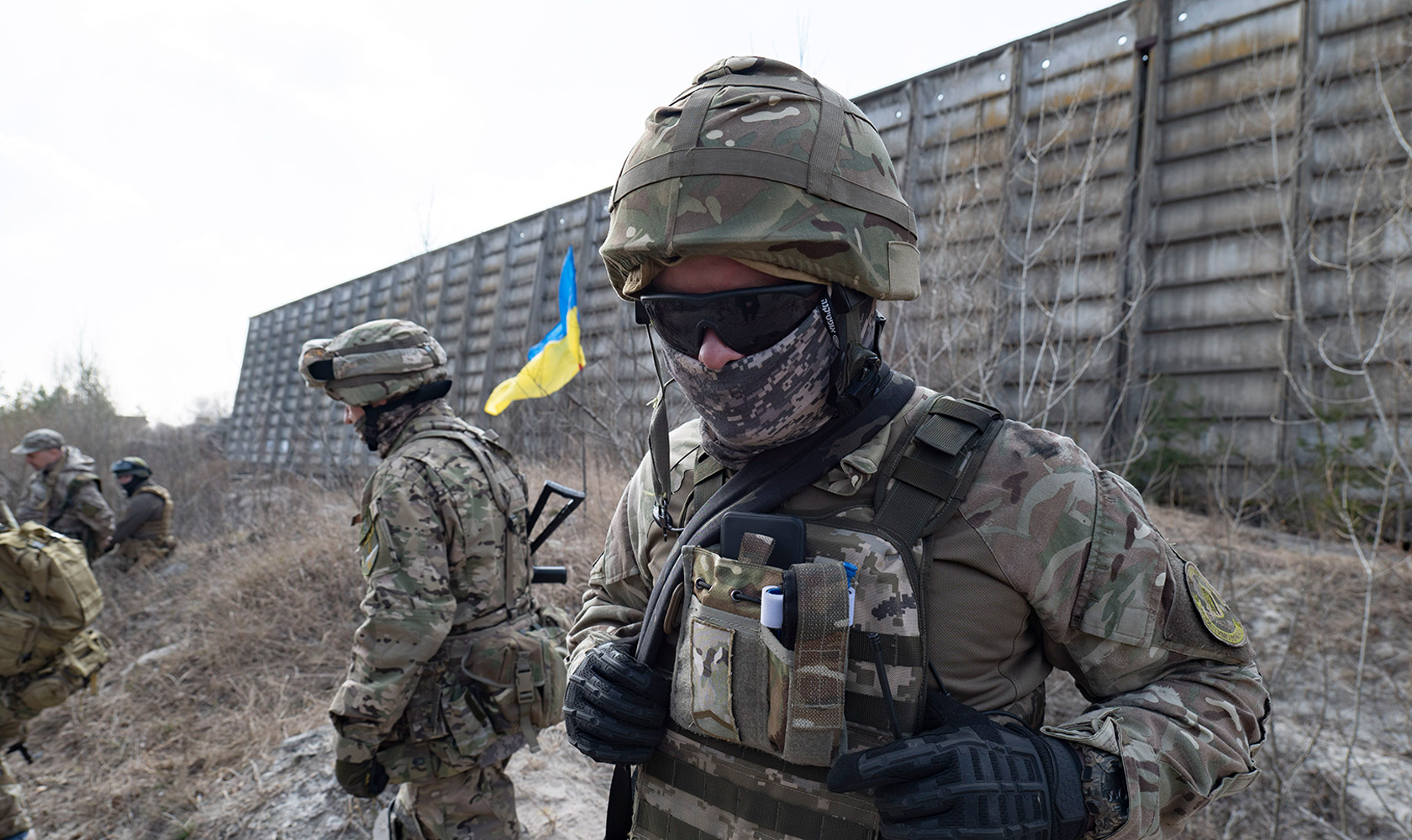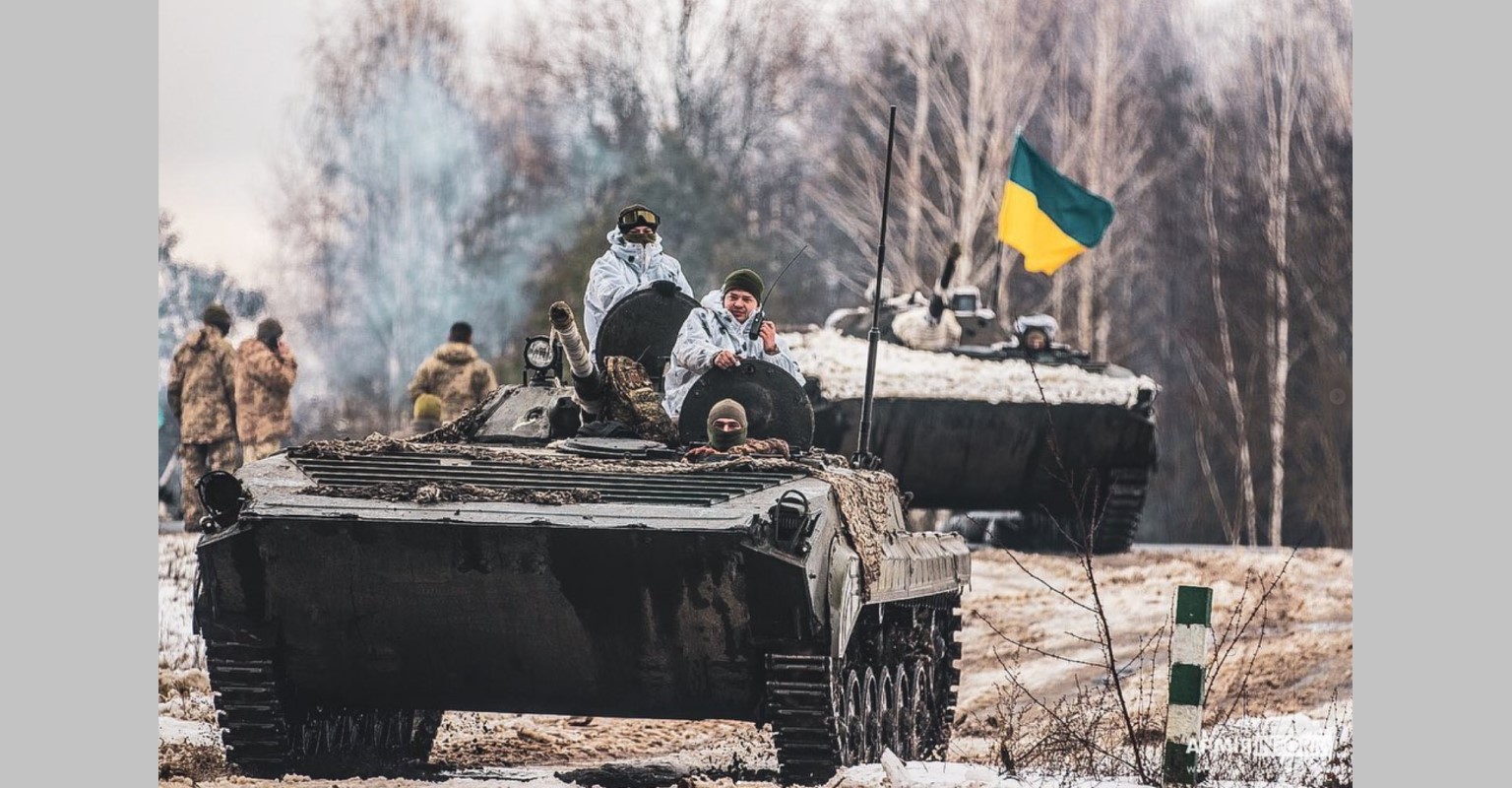Meanwhile, Russian media have once again cranked up propaganda of hatred towards Ukraine.
- Read the previous article: Biden phones Zelenskyy amid Russian troop build-up along Ukrainian borders and escalation in Donbas
Border buildup continues

Some two weeks ago a number of videos surfaced on Russian social media that showed massive military convoys moving on their own or by train. The convoys comprised various military equipment including infantry fighting vehicles, armored personnel carriers, self-propelled howitzers, multiple launch rocket systems, anti-aircraft means, fuel transporters, service support trucks, and other vehicles. The videos were predominantly coming from the regions of Russia, adjacent to Ukraine’s east and south, and from Crimea, and the convoys, as posters claimed, were removing towards Ukraine.
In their take on the situation published on the Russian website theins.ru, the researchers of the Russia-based Conflict Intelligence Team (CIT) studied those videos and, using a publicly available railcar tracking database, confirmed that the Russian troops were moving towards Ukraine and had at least two known destinations, Crimea and the area of Voronezh, the capital city of the namesake Russian region lying only some 100 kilometers away from Ukraine’s northeastern Kharkiv Oblast and bordering on Luhansk Oblast. The convoys included a variety of units, “including motorized, artillery, paratrooper and, most likely, tank units.” Russia is transferring troops from all around the country, including the north of its European part, Ural, Siberia.
Among the military units on move, CIT has identified the 76th Guards Air Assault Division from Pskov and the 74th Motorized brigade, both took part in the Russian invasion of Ukraine’s east back in 2014.
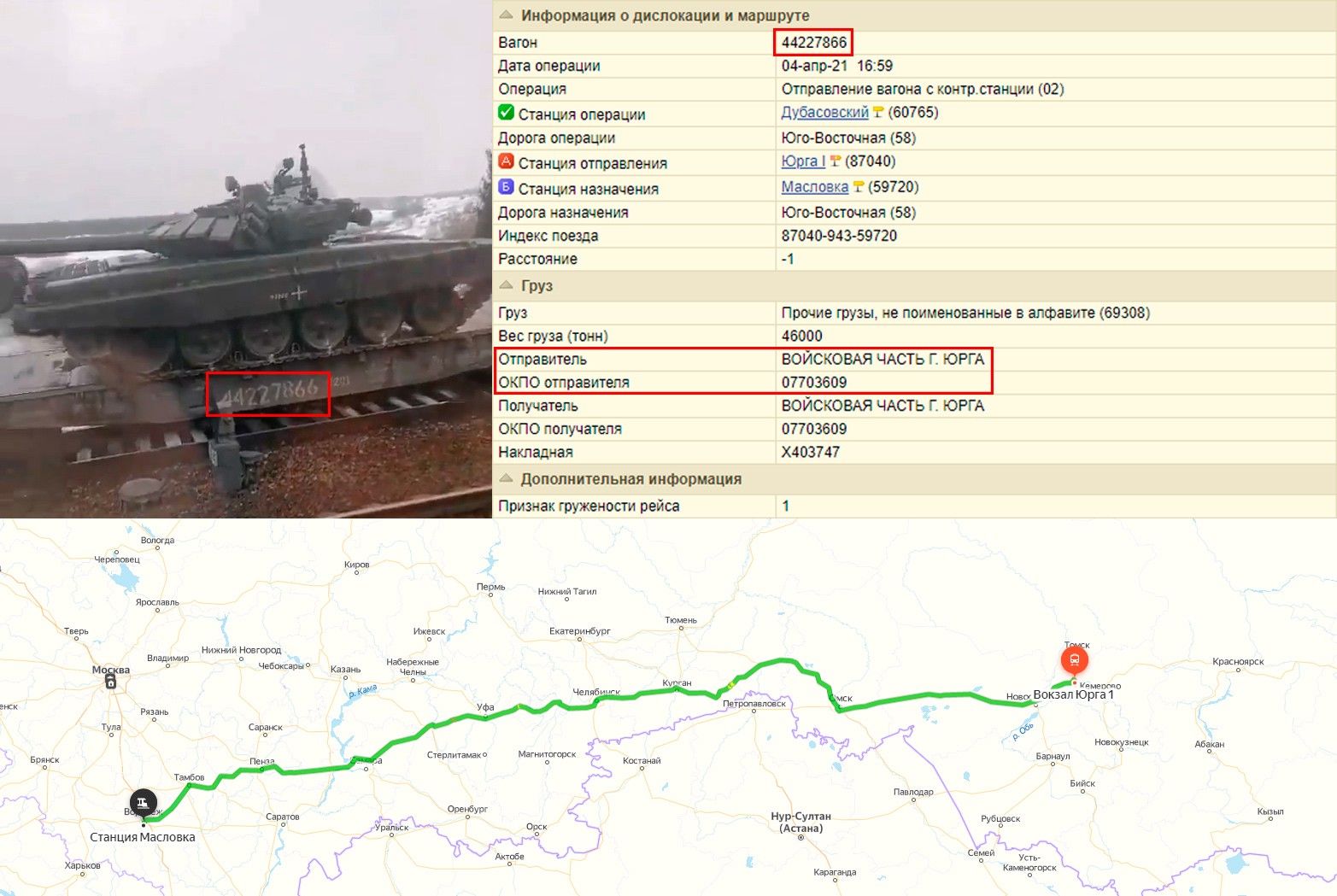
1/
Long-time Ukraine watchers may remember the Russian 76th Guards Air Assault Division, whose soldiers were killed in Eastern Ukraine in summer 2014.https://t.co/H9KNfI6CnP
Well, they are back — and this time, they are riding a train to Crimea.https://t.co/ocJzHrhhtA pic.twitter.com/4cGpce84fn
— CIT (en) (@CITeam_en) April 5, 2021
https://twitter.com/JulianRoepcke/status/1378620707026964481
After the information on the troop movements started circulating in the press, the Russian military didn’t find any better excuse than to call it “exercises” in the Southern Military District. However, not only were any military drills announced in advance as it normally happens but also the geography of the military units involved spread across a number of military districts implies the tactical level exercises, however, the closest ones – Zapad-2021 – are set for September.
CIT says that the same arguments negate the “snap check” excuse announced later, on 6 April, by Russia’s Defense Minister Sergei Shoigu.
“This suggests the units are indeed being sent to put pressure on Ukraine — or prepare for an offensive,” CIT researchers believe, also pointing out that “such a troop concentration near Ukraine is unprecedented since 2014—2015, when Russian regulars operated in Crimea and Ukraine’s eastern Donbas region.”
Hardware with no marks
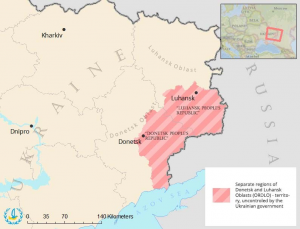
Another troubling indication is that some vehicles in convoys have their number plates, side numbers, and identification signs covered or painted over, which isn’t a usual occurrence at military maneuvers, but this was a case back in 2014-2015 when the troops used to paint over marking attempting to hide the Russian origin of the equipment that was involved in the Russian invasion of the Donbas.
After 2015, the military equipment lacking marking was rarely spotted in the areas of Russia closed to the occupied Donbas.
For example, in 2018 Russia also drew up forces to Ukrainian borders and, in several cases, some pieces of the equipment had their marking painted over. However, the buildup of 2018 was much smaller in scale. Investigators of the Ukrainian investigative community InformNapalm reasonably suggested back in March 2018 that the Russian military was going to send the pieces with obscured marking across the uncontrolled stretch of Ukrainian border to the occupied territory for reinforcing the units stationed there.
By the end of 2018, the buildup gained momentum and Viktor Muzhenko, then-commander of Ukraine’s Armed Forces, called the threat of a Russian full-scale invasion the highest since 2014. Nevertheless, Russia didn’t strike back then and only established permanent military bases not far from the Ukrainian borders.
Now, the video posted on 7 April 2021 shows a train loaded with IFVs having their side numbers overpainted:
https://twitter.com/GirkinGirkin/status/1379808314947727363
Russian convoy watch update: there's been a minor but troubling development.@GirkinGirkin spotted two videos where we can either hear or see for ourselves that parts of the Russian trucks' number plates are obscured: namely the 2-digit codes that denote a military district.
1/ pic.twitter.com/7K2ACECFVi— CIT (en) (@CITeam_en) April 3, 2021
Novaya Usman, Voronezh Oblast. BMP-2 IFVs column. Hull numbers covered.
04.04.21 pic.twitter.com/IQF0gq61x4
— Status-6 (@Archer83Able) April 5, 2021
Voronezh camp
Meanwhile, CIT has also pinpointed the locations of convoys being unloaded near Voronezh and moving towards a newly set-up military field camp south of Voronezh, based on the publicly available videos from social media. The area lies some 250 kilometers drive away from the Ukrainian border which further than similar camps set up 2014-2015 on Ukrainian borders amid the invasion of the Donbas. However, some evidence suggests another camp in the area of Ostrogozhsk, Voronezh Oblast some 100 km away from Ukraine’s Kharkiv Oblast, as other videos of the convoys on the move were geolocated on a highway near Ostrogozhsk.
CIT was unable to geolocate the camp near Voronezh based on videos of military vehicles camping in fields, however, later Christiaan Triebert of New York Times’ Visual Investigations published satellite images confirming “hundreds of military vehicles” in the area, stationed at Pogonovo military training ground where CIT suggested it should have been set up:
https://twitter.com/trbrtc/status/1380069652584230914
What is Russia up to and is the new Russian invasion imminent?
The concentration of Russian troops in two particular areas — near northern Kharkiv and southern Kherson oblasts — gives an idea of what Russia would be going to achieve by military means in case of the full-on war: a simultaneous strike from both sides would be aiming at cutting off most of the eastern half of Ukraine, with the Black Sea Fleet possibly used for taking control of Ukraine’s entire coasts of the Black and Azov seas, including the port cities of Odesa and Mariupol.

If this is the plan, then it might mean that Russia resurrects the so-called Novorossiya project which failed in 2014-2015, now trying to realize it by military means.
At the minimum, Russia might be plotting the invasion for taking control of pumping facilities on the Dnipro River in Kherson Oblast to resume supplying water via the North Crimean Canal to occupied Crimea, where the occupation authorities desperately need it, secure the land corridor to Crimea along the Azov coast across Donetsk and Zaporizhzhia oblasts, and seize the city of Kharkiv in the north. At the maximum, the Russian plan may be to occupy all of Ukraine.
The prevailing opinion among experts is that it is unlikely that Russia is going to offense and the current buildup is for intimidating Ukrainians and submitting the Ukrainian leadership into accepting Russian demands. These could include forcing Ukraine to stop the crackdown on Putin’s allies in Ukraine or to grant autonomy to Russian-occupied parts of Luhansk and Donetsk oblasts and so on.
On the other hand, the plan might be to test the new American leadership and find out how resolute they are when it comes to the support of Ukraine in the wake of the ongoing Russian aggression.
CIT hasn’t found any obvious signs of an imminent invasion yet, such as the military convoys on the border itself. However, the Russian troop buildup has still been in progress and its ultimate goals may become evident in the future with new data available.
Michael Kofman, Senior Research Scientist at CNA, a Virginia-based research and analysis nonprofit, believes,
“My sense looking at this situation is that nothing is necessarily going to happen right now, but if they have offensive operations in mind, they are more likely mid-late April,” he wrote on Twitter.
Does this mean invasion imminent? No. I'm largely where I was last week in that initial analysis. But confidence levels are important. I'm less confident that this is just a coercive demonstration than I was before.
— Michael Kofman (@KofmanMichael) April 5, 2021
Taras Kuzio, Professor, National University of Kyiv Mohyla Academy, doesn’t believe that Russia is going to launch a full-scale invasion of Ukraine as “this would lead to a long war and the complete breakdown of Russia’s relations with the West.”
“Vladimir Putin is more likely to be aiming for a repeat of the trap he laid for Georgian President Mikheil Saakashvili in 2008, when provocations from South Ossetia led to Georgia’s intervention in the separatist region. This gave Russia the excuse to militarily intervene “in defense of its citizens” and humiliate Saakashvili. Russia would love to provoke Ukraine in the same manner,” suggested Taras Kuzio in his comment to the Atlantic Council.
Russian propaganda reruns the “crucified boy” trope
Back in July 2014, a Russian state-owned TV channel made up a propaganda story of a Donbas boy purportedly crucified by Ukrainian soldiers in the city of Sloviansk which later turned out to be fake. Now, referring to the Donetsk occupation authorities, a number of Russian media picked up the similar story of a boy reportedly killed from a Ukrainian drone.
The debunkers of StopFake scrutinized the story and found that initial reports mentioned that a child really died, but not hit by a drone but after he found an explosive device hidden by a local in his garage or home. The OSCE Special Monitoring Group confirmed the death of the child “due to blast trauma and shrapnel wounds,” mentioning nothing about any airstrikes or drops that could have caused it.
Russia’s State Duma speaker Vyacheslav Volodin joined the Russian media campaign meant to instigate hatred towards Ukraine and said that the Ukrainian leadership is responsible for the boy’s death.
Meanwhile, Putin’s press secretary Dmitry Peskov said he didn’t have verified information on the death of the boy, but he believes the Donetsk occupation authorities,
“I have no reason to doubt the veracity of the information on this provided by the self-proclaimed republic. It is difficult to imagine that fake news was made about the child’s death,” he said.
The Ukrainian NGO Ukraine Crisis Media Center commented,
“An emotionally strong manipulation makes it easy to attack the state of Ukraine and justify Russian aggression. Amidst the recent escalation, some experts perceive the recent case as a potential casus belli – a justification for the Kremlin to intensify its attacks.”
- Read also: War scare is Putin’s natural element
Plus, the long-standing campaign to denigrate the Ukrainian military continues in pro-Kremlin media:
this is #Russian equivalent of Rwandan RTLM. Those two anchors dehumanise #Ukrainian soldiers as 'fascists', drug addicts and psychotic deviants. Narrative: That's why #Russians as bearers of higher moral standards should not be afraid of killing them. Aired yesterday, at 18:40 pic.twitter.com/B4vxcxTVow
— Yevhen Fedchenko (@yevhenfedchenko) April 7, 2021
And other anti-Ukrainian narratives have been disseminated as well:
Fake: Ukraine's Parliament has adopted a law that will deprive Ukrainians living at occupied territories of voting rights if they have Russian passports pic.twitter.com/WcVOi483qb
— Stop Fake (@StopFakingNews) April 8, 2021
Escalation in the Donbas
Meanwhile, the Russian buildup unfolds in the foreground of an escalation in the frontline in the east of Ukraine. In the first week of April alone, the Ukrainian command of the Joint-Forces Operation recorded 66 attacks of Russian-hybrid forces on Ukrainian positions in the Donbas, reporting that 4 soldiers were killed and four more wounded.
Here are those killed in the Russian attacks:
49y.o. Viktor Helebrant killed by enemy sniper at Zolote-4, Luhansk Obl on Apr 5.
Born in Nelipyno, Zakarpattia Obl; resided in Krasnokytsk, Kharkiv Obl. In the ranks since 2015, served as junior sergeant in the Otaman Ivan Sirko 92nd Separate Mechanized Brigade.#WarinUkraine pic.twitter.com/cfFnrxH6yH— Euromaidan Press (@EuromaidanPress) April 8, 2021
23y.o. Vladyslav Moroz killed by enemy sniper at Spartak, Donetsk Obl on Apr 5, 2021.
From Khalayidove, Cherkasy Obl. Served in 72nd Separate Mechanized Brigade.
Вічна Пам’ять! Eternal Memory!
Герої не вмирають! Heroes Never Die!#WarinUkraine pic.twitter.com/sGGHZwmuPw— Euromaidan Press (@EuromaidanPress) April 7, 2021
Ivan Kozhemiaka killed in enemy shelling & gunfire in the war zone on Apr 5, 2021.
Ivan was from Nova Borova, Zhytomyr Oblast. He served in the Armed Forces of Ukraine (no other info available).
Вічна Пам’ять! Eternal Memory!
Герої не вмирають! Heroes Never Die!#WarinUkraine pic.twitter.com/FGi1P9Hh8b— Euromaidan Press (@EuromaidanPress) April 7, 2021
Andriy Horlaty killed by an enemy sniper at Bakhmut, Donetsk Obl on April 4, 2021 (no photo available).
Born on Nov 13, 1976; resided in Lutsk. In the Armed Forces since 2018, served as senior mechanic & driver in the 39th Anti-Aircraft Missile Regiment.#WarinUkraine pic.twitter.com/9YgSRaOuKY— Euromaidan Press (@EuromaidanPress) April 6, 2021
Read more:
- Biden phones Zelenskyy amid Russian troop build-up along Ukrainian borders and escalation in Donbas
- Ukraine’s Territorial Defense volunteers prepare to support army in case of Russian invasion
- Moscow will be ready for a war against Ukraine ‘in a month,’ Felgenhauer says
- Three largest Russian militant training facilities identified (2018)

